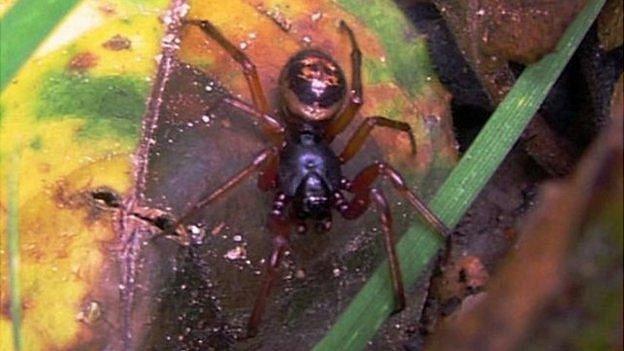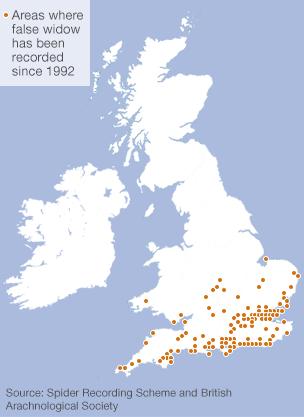How dangerous are false widow spiders?
- Published

A school has been closed because of a venomous false widow spider, and experts say they are on the increase. But how much of a threat do they really pose?
Sightings of Steatoda nobilis, the false widow spider, are on the rise. It is being cited as Britain's most venomous spider, and it is spreading.
But experts say the species is not usually aggressive towards humans and that being bitten is rare.
The species is becoming more common and more widespread, says John Tweddle from the life sciences department at the Natural History Museum, London.
He says that "it's not an influx as such, rather that existing populations are expanding".
And being bitten by one is not very common, explains Dr Tweddle. It's much less common than a bee or a wasp sting.
'Not aggressive'
"There have been very few confirmed incidences of bites from Steatoda nobilis, although adult female false widow spiders are certainly capable of biting humans if handled without due care - the smaller males are not known to cause bites.
"It is not an aggressive species towards humans and is most likely to bite when accidentally prodded or squashed, or trapped in clothing."
The false widow is believed to have arrived in Britain in crates of fruit from the Canary Islands in the late 19th Century, with the first reported sighting in Torquay in 1879.
The species has most likely spread as a response to a changing climate, adds Dr Tweddle.
"We're expecting the species to continue to increase its distribution within the UK. We tend to spot spiders most frequently during the Autumn as this is when many of the UK's larger species reach maximum size, so are most visible."
The symptoms of a bite range from feelings of numbness, severe swelling and discomfort, to various levels of burning or chest pains. The severity of the symptoms depends on the amount of venom that was injected.
There have been no reported deaths from its bite in the UK.
Although a bite is very uncomfortable, it's no stronger than a wasp sting, says Mark Champion from the Wildlife Trust. There is also a greater chance of dying from a wasp or bee sting, he adds.
"The bite that it gives is mainly defensive, so it's not coming out to get you, it's not a horror movie," he told BBC Breakfast..

"The swelling can become the size of a tennis ball. It can be something quite big but it's not something we all need to panic about."
'Scaremongering'
A footballer was recently bitten by a false widow in his sleep had to undergo surgery to cut away the area around the bite.
One newspaper has also reported that a man was left fighting for his life, external after a bite on his foot.
Sara Goodacre from the University of Nottingham's Spider Lab, says there seems to be a "disproportionate worry" about the creatures and that such media reports are "scaremongering".
False Widows are extremely prevalent in France and Spain, yet there are rarely reports of holiday makers being bitten, Dr Goodacre told BBC News.
Furthermore, she adds, some of the media reports of the bites are not consistent with the effect a neurotoxin - present in a false widow's venom - would have.
Responding to the footballer surgery, Dr Goodacre says: "That's what you would need to do with a venom that's slowly breaking down the tissue, which some snake and spider venoms do - but not the false widow.
"People aren't always reporting the same consistent symptoms. It's important to work out if we are talking about the same thing, or whether it's an allergy where the symptoms depends on the person that's bitten.
Meet David Haigh, the man charged with counting Gloucestershire's false widows
"This [false widow's] neurotoxin doesn't seem to do that. At best it's very unclear, at worst it's scaremongering."
False culprit
The bottom line, Dr Goodacre says, is that the false widow spiders should not be a problem as they are not aggressive.
"Some people are clearly having a reaction to something so the question is what is it? If there is a problem we should investigate it further."
According to the British Arachnological Society, external, false widows might occasionally be the subjects of mistaken identify.
"It is difficult to obtain accurate evidence as those complaining of bites often do not see the spider but assume they are the culprit because of the absence of a bee or wasp," said the society.
"Alternatively, they only get a brief glimpse. Rarely is the spider captured so that an accurate identification can be carried out."
- Published23 October 2013
- Published22 October 2013
- Published10 October 2013
- Published4 October 2013
- Published30 August 2012
- Published22 February 2012